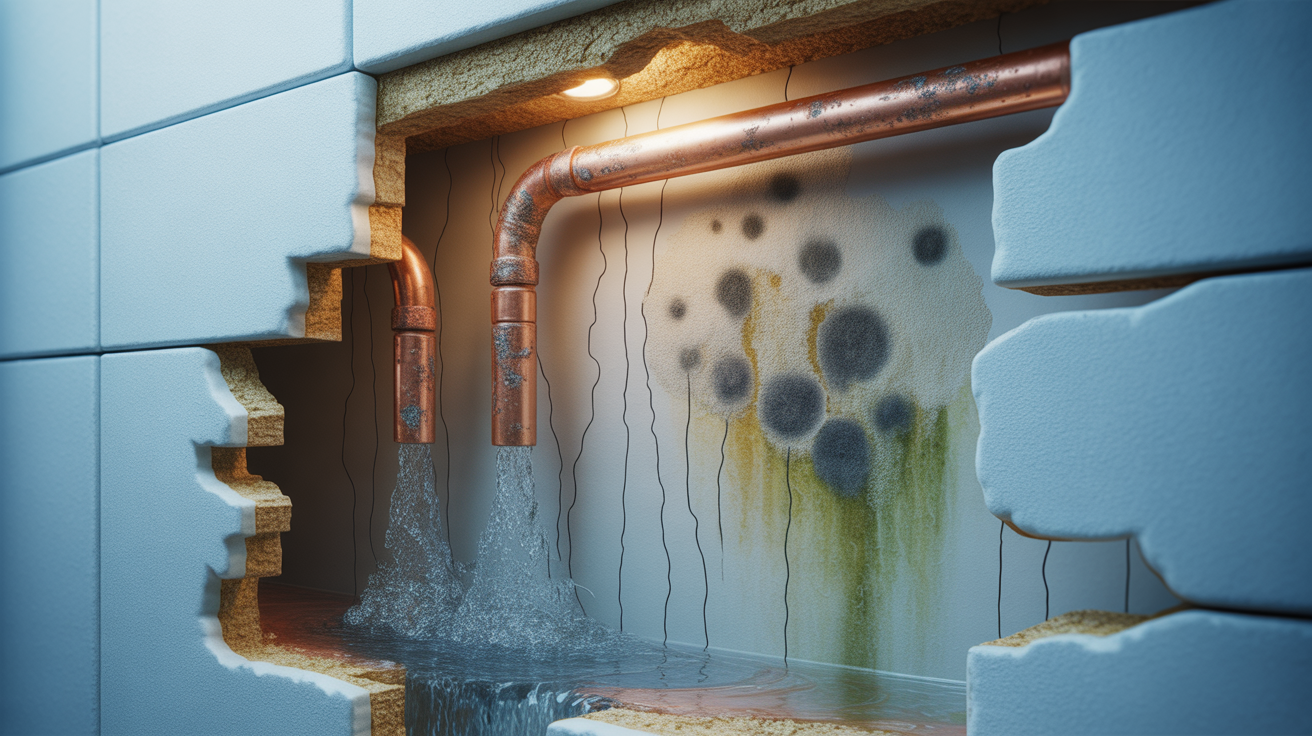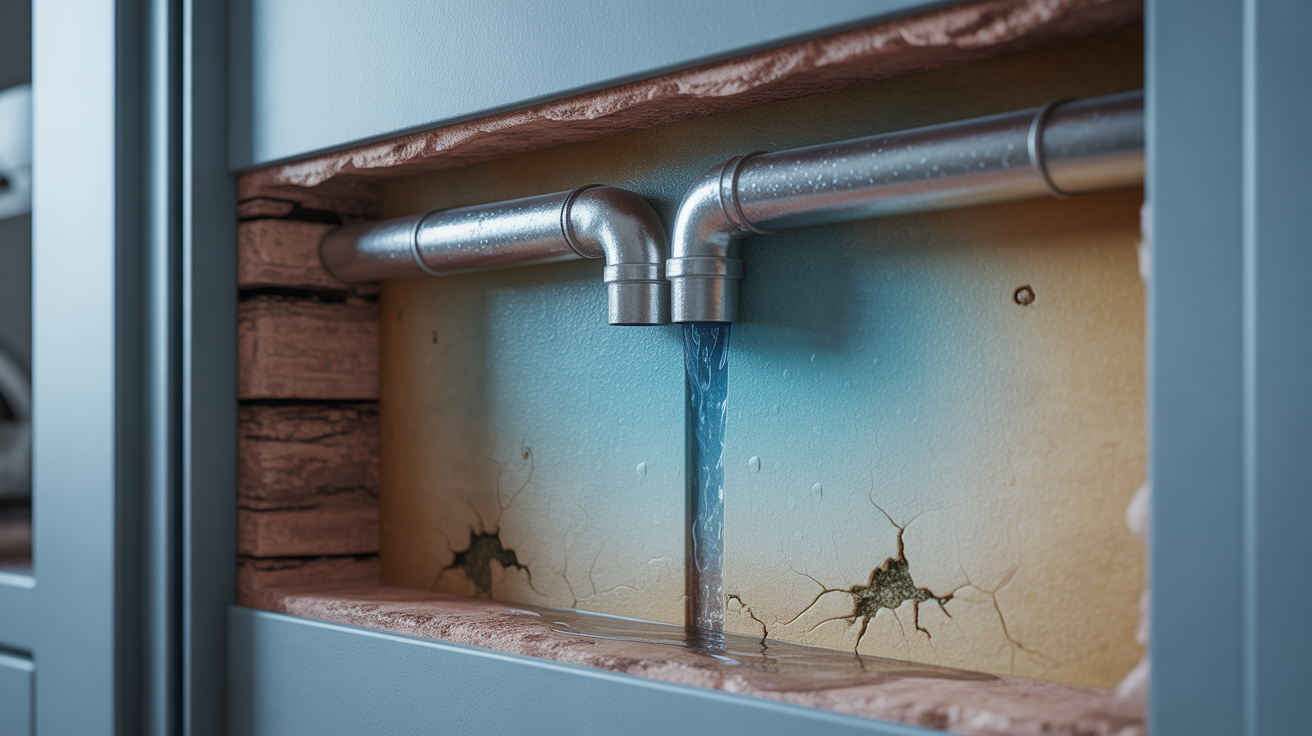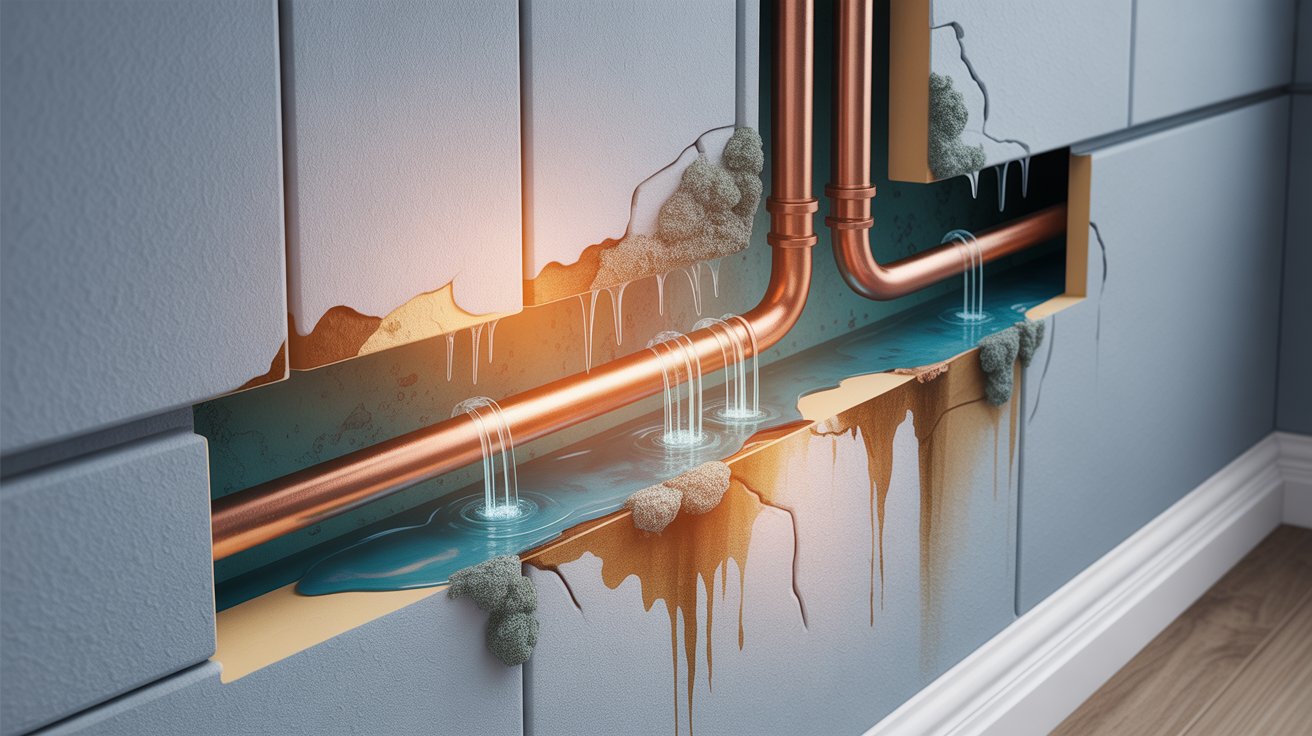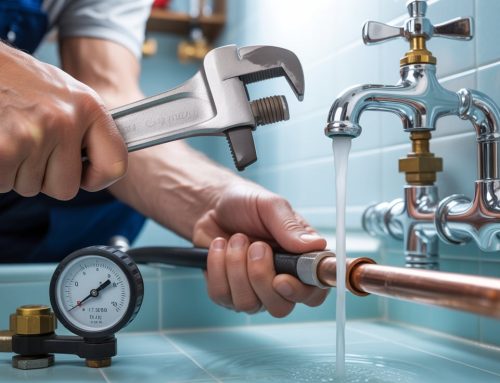5 Signs Your Pipes Are Leaking Inside the Wall: Leaking pipes inside walls can be a homeowner’s nightmare, often going unnoticed until significant damage occurs. These hidden leaks can lead to mold growth, structural damage, and costly repairs if not addressed promptly. Identifying the signs early is crucial to mitigating these risks. This article explores five key indicators of a pipe leak within your walls, offers practical advice on what to do, and provides preventive measures to protect your home. By understanding these signs, you can take swift action to safeguard your property and avoid expensive consequences.
Understanding Leaking Pipes
Why Leaks Happen
Pipes hidden within walls can leak due to various reasons, including:
- Corrosion: Aging metal pipes can rust or corrode, leading to pinhole leaks.
- High Water Pressure: Excessive pressure can stress pipes, causing them to crack.
- Joint Failures: Poorly sealed or worn-out pipe joints may leak over time.
- Physical Damage: Construction work or shifting foundations can damage pipes.
Why Early Detection Matters
Leaks inside walls are particularly dangerous because they’re concealed, allowing water to seep into drywall, insulation, and wooden structures. Early detection prevents mold, weakens structural integrity, and reduces repair costs.
5 Signs Your Pipes Are Leaking Inside the Wall

5 Signs Your Pipes Are Leaking Inside the Wall
1. Unexplained Water Stains or Discoloration
What to Look For
Yellowish, brown, or water-stained patches on walls, ceilings, or floors are a telltale sign of a hidden leak. These stains often appear in irregular shapes and may spread over time.
What to Do
Inspect the area for dampness and note if the stain grows. Contact a plumber to trace the source, as the stain’s location may not directly align with the leak.
2. Musty Odors or Mold Growth
What to Look For
A persistent musty smell, especially in enclosed spaces like basements or bathrooms, can indicate moisture from a leak. Visible mold or mildew on walls or baseboards is a strong warning sign.
What to Do
Ventilate the area and avoid direct contact with mold, which can be hazardous. Hire a professional to assess the leak and a mold remediation expert if necessary.
3. Unusually High Water Bills
What to Look For
A sudden spike in your water bill without increased usage suggests a leak. Even small, continuous drips can waste significant amounts of water.
What to Do
Check your water meter before and after a period of no water use (e.g., overnight). If the meter changes, you likely have a leak. Call a plumber for a thorough inspection.
Read More:
Blocked Drains? Here’s What You Should and Shouldn’t Do
DIY vs Professional Handyman in Singapore
Top 7 Reasons to Hire a Professional Handyman in Singapore
4. Sounds of Running Water
What to Look For
Hearing dripping, trickling, or hissing sounds inside walls when no taps are running is a clear sign of a leak. These sounds are often more noticeable at night when the house is quiet.
What to Do
Try to pinpoint the sound’s location and shut off the main water supply to confirm if it stops. A plumber can use acoustic detection tools to locate the leak precisely.
5. Warped or Damaged Walls
What to Look For
Walls that feel soft, spongy, or show signs of bubbling, peeling paint, or warping indicate water damage from a leak. Floors near walls may also buckle or feel damp.
What to Do
Avoid pressing on damaged areas to prevent further structural harm. Contact a plumber immediately and consider a contractor to assess wall damage.

5 Signs Your Pipes Are Leaking Inside the Wall
What to Do If You Suspect a Leak
Immediate Actions
- Turn Off the Water Supply: Shut off the main water valve to minimize damage.
- Document the Damage: Take photos of stains, mold, or warped walls for insurance claims.
- Contact a Professional: A licensed plumber can use tools like thermal imaging or moisture meters to locate and repair the leak.
Long-Term Solutions
- Replace Old Pipes: Consider replacing aging pipes with modern materials like PEX or copper.
- Install Leak Detectors: Smart water leak detectors can alert you to issues early.
- Regular Inspections: Schedule annual plumbing inspections to catch potential problems.
Preventive Measures
Regular Maintenance
- Check Water Pressure: Use a pressure gauge to ensure your home’s water pressure is within a safe range (40-60 psi).
- Inspect Exposed Pipes: Look for signs of corrosion or wear in accessible areas like basements.
- Insulate Pipes: Protect pipes in cold climates to prevent freezing and bursting.
Homeowner Tips
- Keep an eye on water bills for unexpected increases.
- Avoid hanging heavy objects on walls near plumbing to prevent pipe stress.
- Educate household members about signs of leaks to ensure early reporting.
Conclusion
Hidden pipe leaks inside walls can cause significant damage if left unchecked, but recognizing the signs early can save you from costly repairs. Water stains, musty odors, high water bills, unusual sounds, and warped walls are clear indicators that something is amiss. By acting quickly, using professional help, and adopting preventive measures, you can protect your home from the devastating effects of leaks. Stay vigilant and proactive to keep your plumbing system in top condition.
FAQs
General Questions
- What causes pipes to leak inside walls?
Corrosion, high water pressure, joint failures, or physical damage are common causes. - How can I tell if a leak is inside the wall?
Look for water stains, musty odors, high water bills, running water sounds, or warped walls. - Can a small leak cause significant damage?
Yes, even small leaks can lead to mold, structural damage, and increased water costs over time. - How long does it take for a leak to show visible signs?
It varies, but signs like stains or mold can appear within days or weeks, depending on the leak’s severity. - Are hidden leaks covered by homeowners’ insurance?
Coverage depends on the policy and cause. Document damage and contact your insurer for details.
Detection and Diagnosis
- How can I confirm a leak without breaking walls?
A plumber can use thermal imaging, moisture meters, or acoustic devices to locate leaks non-invasively. - What should I do if I hear water running in the walls?
Shut off the main water supply and call a plumber to investigate immediately. - Can high water pressure cause leaks?
Yes, excessive pressure can stress pipes, leading to cracks or joint failures. - How do I check my water meter for leaks?
Turn off all water sources and check the meter. If it moves after a few hours, you have a leak. - What does mold from a leak look like?
It appears as black, green, or white patches, often with a musty smell, on walls or baseboards.
Immediate Actions
- Should I turn off the water if I suspect a leak?
Yes, shutting off the main water valve prevents further damage until a plumber arrives. - Can I fix a wall leak myself?
Unless you’re experienced, it’s best to hire a plumber to avoid worsening the damage. - How do I document a leak for insurance?
Take clear photos of stains, mold, or damage and note the date and time of discovery. - What tools do plumbers use to find hidden leaks?
Common tools include thermal cameras, moisture meters, and acoustic leak detectors. - How urgent is a suspected wall leak?
Act immediately, as delays can lead to mold, structural issues, or higher repair costs.
Prevention and Maintenance
- How can I prevent pipe leaks?
Maintain safe water pressure, insulate pipes, and schedule regular plumbing inspections. - What are smart leak detectors?
These devices monitor water flow and alert you to leaks via a smartphone app. - How often should I inspect my plumbing?
Annual professional inspections can catch potential issues early. - Can old pipes be replaced to prevent leaks?
Yes, replacing aging pipes with materials like PEX or copper reduces leak risks. - Are certain pipe materials more prone to leaks?
Older materials like galvanized steel or lead are more likely to corrode and leak than modern options.



